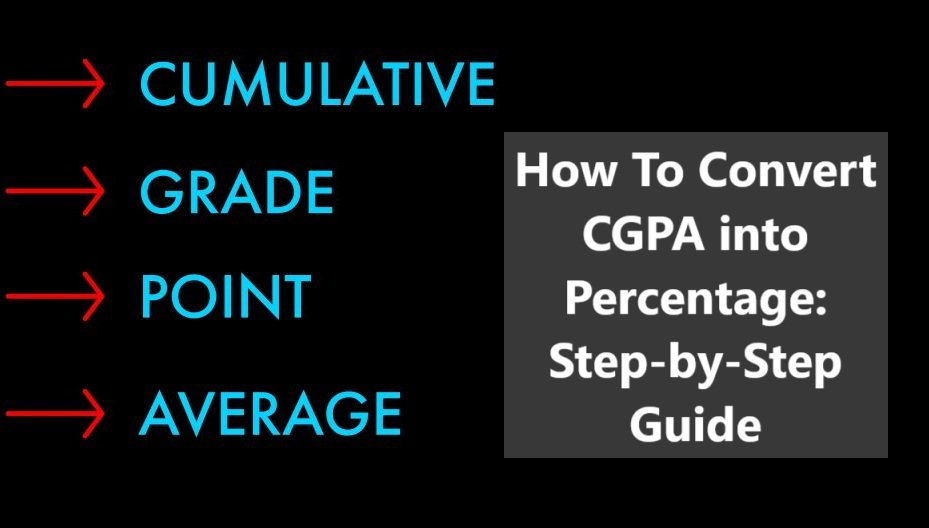
Introduction
Cumulative Grade Point Average (CGPA) is a widely used grading system in many educational institutions. While CGPA simplifies academic performance assessment, many universities, employers, and competitive exams require scores in percentage form. Converting CGPA into percentage ensures uniformity and clarity in evaluating academic achievements. This step-by-step guide explains the methods, formulas, and important considerations for accurate conversion.
What is CGPA?
CGPA stands for Cumulative Grade Point Average. It represents the average of grade points obtained in all subjects, excluding additional subjects. The CGPA system reduces the pressure of scoring exact marks and instead focuses on overall academic performance.
Why Convert CGPA into Percentage?
- Academic Requirements: Many universities and colleges require percentage scores for admissions.
- Job Applications: Some employers prefer percentages to evaluate candidates’ academic records.
- Scholarships and Exams: Several scholarships and competitive exams mandate scores in percentage format.
- International Applications: For studying abroad, converting CGPA to percentage may be essential for equivalence.
Standard Formula for Converting CGPA into Percentage
Different institutions follow varied formulas, but the most commonly accepted formula is:
Percentage (%) = CGPA × 9.5
Example: If a student has a CGPA of 8.4:
Percentage = 8.4 × 9.5 = 79.8%
This formula is widely used in Indian education systems like CBSE.
Step-by-Step Guide to Convert CGPA into Percentage
Step 1: Identify Your CGPA
Check your mark sheet or transcript for the CGPA score provided by your institution.
Step 2: Confirm the Institution’s Conversion Formula
Different boards and universities may have unique conversion methods. Always verify the formula from official guidelines.
Step 3: Apply the Formula
Multiply your CGPA by the specified multiplier (commonly 9.5).
Step 4: Round Off (If Required)
Some institutions allow rounding off percentages. Check official instructions before doing so.
Step 5: Cross-Verify
Ensure that your conversion aligns with the institution’s official conversion norms.
CGPA to Percentage Conversion for Different Universities
- CBSE (India):
- Formula: Percentage = CGPA × 9.5
- Jawaharlal Nehru Technological University (JNTU):
- Formula: Percentage = (CGPA – 0.5) × 10
- Anna University:
- Formula: Percentage = (CGPA – 0.75) × 10
- Mumbai University:
- Formula: Percentage = (7.1 × CGPA) + 11
- Other Institutions:
- Refer to the official academic handbook for specific formulas.
Online Tools for Conversion
Interactive CGPA to Percentage Calculator
CGPA to Percentage Calculator
Common Mistakes to Avoid
- Assuming a universal conversion factor.
- Ignoring institution-specific conversion rules.
- Rounding off percentages incorrectly.
- Not cross-checking with official academic sources.
FAQs on CGPA to Percentage Conversion
Q1: Is the 9.5 multiplier applicable worldwide?
A1: No. The 9.5 multiplier is commonly used by CBSE. Other institutions may have different formulas.
Q2: How accurate are online converters?
A2: They are accurate only if they use the correct institutional formula.
Q3: Can CGPA be converted to marks directly?
A3: No. CGPA converts into percentage, not raw marks.
Q4: What if my institution does not provide a conversion formula?
A4: Contact the examination department or refer to national education standards.
Conclusion
Converting CGPA into percentage is essential for academic and professional purposes. The conversion process is straightforward if you follow the institution-specific formula. Always refer to official guidelines and cross-verify your results. For students planning higher studies or job applications, presenting scores in both CGPA and percentage formats ensures clarity and avoids misunderstandings.
Final Tip: Double-check conversion norms before submitting applications to avoid discrepancies that might affect admissions or job prospects.





